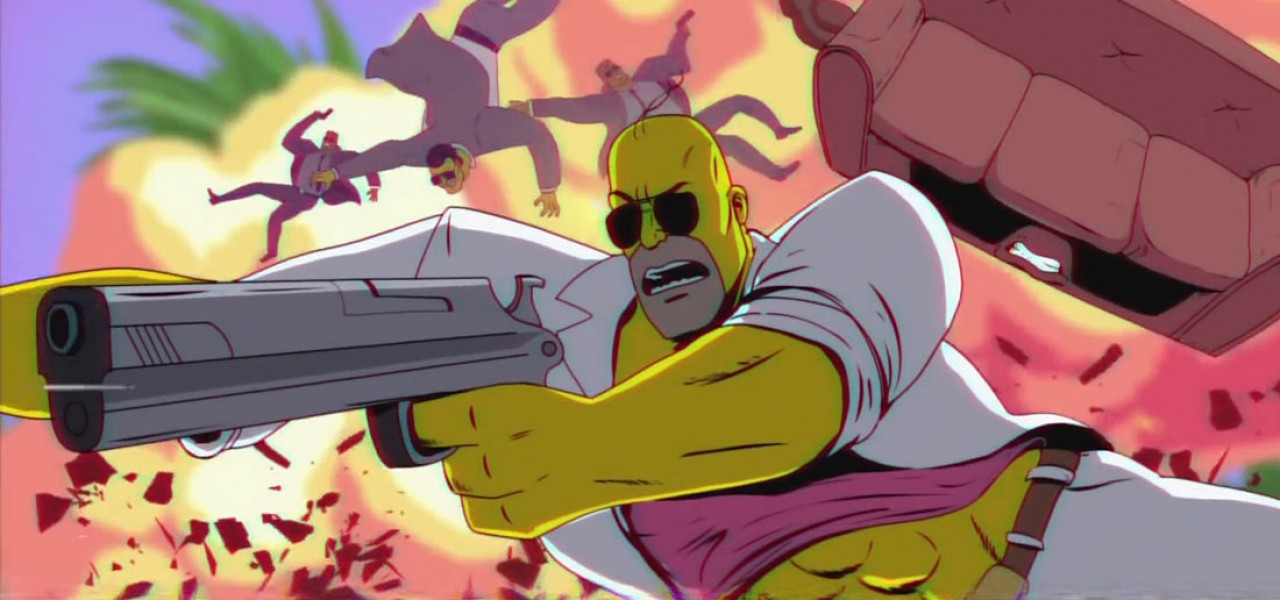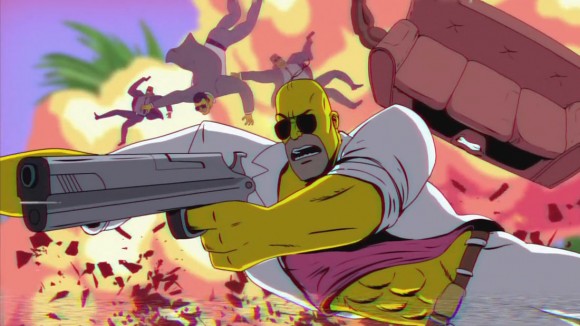

How Making Online Shorts Landed Steve Cutts A ‘Simpsons’ Couch Gag Opening
The guest creator-couch gag has become a fixture of The Simpsons over the last few seasons. The tradition began in 2010, with a sequence devised by Banksy; since then, such animation icons as Sylvain Chomet, Don Hertzfeldt, and John Kricfalusi have crafted couch gags in their own personal styles.
Compared to those prior guests, the most recent artist to be given the reins of the iconic opening, London-based filmmaker Steve Cutts, is a relative newcomer to the animation scene. He’s also representative of the changing world of animation, in which reputations are often built online rather than film, television, or festival circuits.
Cutts, who studied sculpture in art school, shifted to illustration to make a living. While working at an East London ad agency, he started teaching himself Flash and After Effects, and posting his finished pieces online. On December 21st, 2012 — what was supposed to have been Doomsday — he uploaded Man, a quirky personal take on man’s relationship to the environment. It was the first of his shorts that would become an online hit.
“It was a massive surprise when it went viral and seemingly overnight it was everywhere,” Cutts told Cartoon Brew via email. “Suddenly I had hundreds of emails flooding in, with offers of collaboration and film distribution that I’d never had before.”
Cutts accrued additional online cred in 2014 with Where Are They Now?, a film that made cartoon characters vulnerable to the same daily hardships faced by humans, like unemployment, weight gain, and aging.
His Simpsons couch gag pursues a similar theme of cartoon makeover, but this time in the opposite direction. Opening the Simpsons episode titled “Teenage Mutant Milk-Caused Hurdles,” Cutts’ “LA-Z Rider” opening finds Homer transformed into a macho tough guy, drenched in the sweaty glamour of an Eighties cop show.
Musclebound, toting guns and sporting dark glasses (and that’s just his couch!), the new-look Homer is shown battling an evil, cigar-chomping Ned Flanders against a neon background. From the wailing synth-pop theme song to the LCD display on Homer’s Knight Rider-esque couch, the sequence perfectly captures the glorious kitsch of the era.

“The Simpsons’ producers basically got in touch directly and asked if I’d want to do an intro,” Cutts says. “I’d grown up watching The Simpsons every week, so to be part of that legacy was a bit of an honor to say the least.” His brief from the producers of the series was that the sequence must contain the Simpsons themselves alongside the couch; everything else was up to him.
The most difficult part was whittling down the “hundreds of ideas and directions going through my head,” he says. His illustration work makes pointed criticisms of today’s consumer culture, but he decided against going down that bleak path with his opening.
“I toyed with the idea of doing something darker in tone, with more social commentary, or even a comment on the nature and longevity of the show in general, but I felt that both Banksy and [Don] Hertzfeldt had already covered this territory.” Cutts finally settled on something altogether more light-hearted, and set about creating a vision of Springfield “where everyone is ripped as hell and living the Eighties dream.”
Reminiscent of the way in which Guillermo del Toro filled his Halloween couch gag with horror icons, Cutts considered offering a parade of specific 1980s pop culture references – Mr. Burns and Smithers do appear as Doc Brown and Marty from Back to the Future – but this turned out to be an unwieldy prospect, especially when it came to rights clearances. The sequence instead uses Miami Vice as its main reference point, while working in additional stylistic touches from Saturday morning cartoons of the era, like He-Man and G. I. Joe. (The neon grid is a tribute to the opening of M.A.S.K.)

The sequence has its share of Easter eggs: familiar Simpsons characters turn up in new guises, with Bart and Lisa sporting teenage fashions of the period, while Dr. Hibbert and the Comic Book Guy become gangsters.
“The fun part was choosing who would be the good or bad guys. Ned was the natural choice for the bad guy,” says Cutts. “Even when realizing Ned as a realistic looking human being, he naturally looks like someone with a shady past.” Viewers have pointed out that crimelord Ned bears a distinct resemblance to Bryan Cranston’s character in Breaking Bad. Cutts says that was unintentional, though “maybe I was channelling Heisenberg when I created him.”
From sculpting to illustration to animation, Cutts’ circuitous path to Simpsons stardom has been an unlikely one. When asked about what tips he can offer to other artists attempting to navigate the topsy-turvy world of freelance animation and illustration, he advises having a patient attitude. “One of the main things is to stick at it and be prepared to put in the time,” he says. “As basic as that sounds, a lot of people are disillusioned when things don’t take off immediately.”
Cutts understands that the Internet is the great equalizer for independent artists like himself. “It’s never been easier to get your work out there. The old attitude of ‘you can’t make a living at art’ just doesn’t apply today, when the industry relies on creative professionals to realize its vision.”
